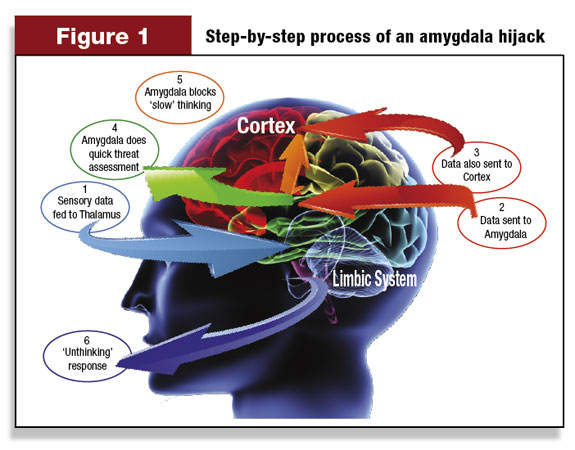Low milk price, high costs of feed, an employee with a really bad attitude – now SCC has spiked for the week – can you take all the pressure? All of a sudden, someone comes and adds to the bad news; you react and you unleash a reaction all human beings have been dealing with since humankind has been around. Even though the thinking human brain has somewhat evolved over thousands of years, there are parts of the human brain that haven’t had a hardware upgrade in about 100,000 years. According to world-renowned emotional intelligence expert Daniel Goleman, most of us are still acting out of the ancient fight-freeze-or-flight response, and an upgrade is long overdue.
If we upgrade farming equipment, milking equipment, computers and systems, what about upgrading our leadership skills? Emotional and social intelligence makes a huge difference in leadership effectiveness today and for the time ahead.
Emotional intelligence is at the core of leadership competence. Emotions make us pay attention right now – this is urgent – and give us an immediate action plan without having to think twice. The emotional component evolved very early: Do I eat it, or does it eat me? – you don’t sit around and Google it.
That emotional response can “take over” the rest of the brain in a millisecond if threatened. Today the threat is symbolic (“he’s not treating me fairly”), but we respond with the same biological response.
Scroll down or to watch a video of Jorge discussing emotional intelligence. To see this same video in Spanish, click here.
Let’s call this eruption in emotions an “amygdala hijack.” Why? The amygdala is the center of the brain that controls this response and also controls empathy – when it feels threatened, it can respond not just irrationally, but destructively.
“When Mike Tyson bit Evander Holyfield’s ear, it was a very bad business decision – it cost him $3 million. It was an amygdala hijack,” says Goleman.
Amygdala hijacks on dairies may not get an exact dollar figure, but the costs can be huge, ranging from loss of engagement or motivation in employees, great employees who leave the dairy, broken partnerships, damaged relations with suppliers or vendors, divorces and the energy wasted by the leader, to name a few. We will describe the physiology and anatomy of the amygdala later.
Here are three signs of an amygdala hijack: Strong emotional reaction, sudden onset and “when you reflect later, you realize it was inappropriate.” The opposite of an amygdala hijack is emotional intelligence – the integration of the emotional center and the executive center of the brain.
Interestingly, boredom also correlates poorly with emotional intelligence. “When your amygdala is hijacked, or when you’re bored, your performance is very poor, despite your abilities,” explains Goleman.
The emotionally intelligent person is engaged, focused, motivated and attentive, and matches these skills to the situation. In other words, a more effective leader.
And one of the hallmarks of an emotionally intelligent leader is the ability to reshape the emotional landscape of a potentially troublesome situation. As Goleman puts it, “When you realize that emotions are contagious, you understand a primal task of a leader."
"Your spleen, your lymphatic system couldn’t care less about the spleen or lymphatic system of the other person – but emotions are designed to be in tune.”
Thus, humor and empathy are traits that can de-escalate conflict and help move toward a working consensus of how to handle the problem – while emotionally unintelligent behavior such as visible anger creates contagion of unpleasant emotions, and makes it tough to get anything resolved.
“Observing videos of the best leaders, they got people to laugh three times more often. It’s a brain-to-brain link,” says Goleman.
Many emotionally and socially intelligent dairy leaders have three qualities for dealing with amygdala attacks:
1. From a willingness and vulnerability to want to learn more about themselves comes an ability to do self-observation in the moment, paying attention to themselves, their mind, their emotions, their body.
2. From their observation they create choices: Either continue down the path they are on or shift to one or a few of an array of ways of being.
3. From their choices, they modify behaviors, minimizing behaviors that erode their effectiveness and maximizing behaviors that engage people and create forward movement and action that produce tangible results for the dairy.
Goleman studied core competencies at 500 organizations, and found that emotional intelligence – interacting with people in a way that makes them feel valued and thus leads them to value their interactions with you – is twice as important in all jobs at distinguishing the best from the average.
The same for dairy leaders – emotional intelligence is 80 to 90 percent of the distinguishing competencies. The more people are in supervisory, management and owner positions, the more it matters. Too often, however, dairies and family businesses run on the “Peter Principle” of promoting people until they’ve gone past their ability to be effective.
They got promoted because of their technical competence (best breeder, best milker, best feeder), but now that they have people reporting to them, they can’t make the transition. The lesson for dairies, of course, is to hire and promote people who display substantial emotional intelligence – and this can have a major positive impact on your business.
In a study of 4,000 leaders and their direct reports, the style of leadership is the biggest driver of climate: 70 percent. And climate affects 20 to 30 percent of business results. Bottom line, there is money on the table.
Let’s set an example in motion where you might see yourself in the picture. One client (“Joe”) has had numerous bad experiences with employees with really bad attitudes. Over the last few years, he’s felt more and more worn down by angry phone calls and in-person encounters, time-wasting arguments that don’t get anywhere and general incivility.
One opposing counsel (“Fred”) was particularly nasty. Joe had been litigating against Fred for just over a year, and he had recognized that Fred’s strategy was to make him angry. So each time he had to interact with Fred, he braced himself and prepared for something outlandish.
But there was one particular tactic that really drove Joe over the edge. The tactic itself doesn’t matter – let’s say it was being accused of unprofessional conduct – and each time Fred would use this tactic, Joe would become enraged.
To his credit, he was able to manage that anger reasonably well, but enough was revealed that Fred knew he’d found the “right” weapon. All Fred had to do was use a few choice words and Joe would become ballistic. He described a tingling sensation throughout his body, the awareness that his blood pressure had spiked and great difficulty with remaining engaged on the topic at hand.
What Joe experienced is an “amygdala hijack.” The amygdala is the “fight-or-flight” and emotional memory part of the brain. Its job is to protect by comparing incoming data with emotional memories. An amygdala hijack occurs when we respond out of measure with the actual threat because it has triggered a much more significant emotional threat.
For instance, the amygdala will react similarly to the threat of being eaten by a tiger (physical threat) and the threat of an ego attack (emotional threat) by bringing on the fight-freeze-or-flight reaction.

Let’s use the illustration ( Figure 1 ) to understand ourselves better. When one experiences an amygdala hijack, the amygdala overtakes the neocortex (the thinking part of the brain) and there’s little or no ability to rely on intelligence or reasoning (the chemicals and hormones that are part of the reaction somewhat cloud the thinking mind).
The effect is that energy is drawn exclusively into the hijack. The immediate result of a hijack is a decrease in working memory.
Adrenaline is released and will be present and effective for 18 minutes, and other hormones are released into the bloodstream that will take three to four hours to clear. That is why when some time has passed (minutes, hours or days) after these types of reactions, leaders go “uh-oh” – What did I do?
How was I being? What was the impact of my behaviors (the costs)? What damage did I cause? Of course some will say, “I don’t care” and some will realize what they did and will go try to ask for forgiveness, and there will be every reaction in between.
Some leaders can still be hijacked years later about a situation, and others may be edgy and explode because they never dealt with it and negative emotions are still on the surface.
As an executive coach working with leaders in different types of business, all dealing with daily challenges, I recommend the following steps to deal with an amygdala hijack:
• Stop . Stop whatever you’re doing. Joe’s strategy was to put the call on hold or to step out of the room for a minute – if that was impossible, he would go silent for a moment and identify for himself what had just happened. (“Ah, Fred just said again that I’m unprofessional.”) This step keeps the neocortex engaged and can prevent the amygdala’s takeover.
• Oxygenate. Breathe deeply, with intention and purpose. This step also keeps the neocortex engaged. There is a reason your Mom told you to count to ten.
• Strengthen appreciation. It’s difficult to have two emotional experiences at the same time, and appreciation counters the hijack. While it’s especially effective to appreciate the source of the hijack (i.e., for Joe to appreciate Fred as a person, to appreciate his zealous representation of his client, etc.), any appreciation will be helpful. Not surprisingly, Joe found it difficult to appreciate Fred, so he would instead think about his family and bask in his appreciation of his wife and children.
• Survey the landscape. After the hijack, spend some time exploring what happened and why. Recognizing the trigger will allow you to avoid being triggered in the future. After recognizing that Fred tended to trot out the accusation of unprofessional conduct when he didn’t get an extension or some other accommodation, Joe was prepared.
He knew that his work had been successful when Fred one day expressed his surprise at Joe’s lack of professionalism, and Joe was able to laugh and respond, “Come on, Fred, we both know that isn’t true and isn’t the point. Feel free to make your motion, but I can’t consent to another delay in this case.”
• Ask for a time-out. I know this may seem ridiculous in the business setting, but giving yourself a time-out can allow you the time you need to clear yourself without going into a situation that you will later regret.
• Notice your emotions earlier and earlier. This is the skill mentioned above that comes from self-observation, creating choices, and modifying behaviors. When you notice yourself earlier and earlier, you get a kind of power and self-mastery that only comes from having different possibilities for ways of being, and being the leader the situation and/or the person needs the most in that moment, for you to be the most effective leader. PD
VIDEO






